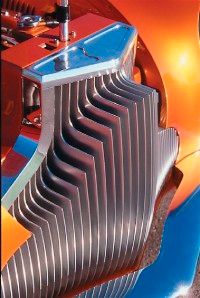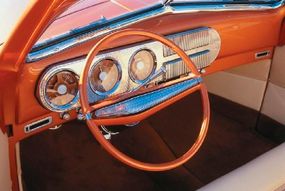At its core, customizing is modifying a car to improve its looks. Removing parts can make a design flow better, and no changes should be made unless they enhance the overall aesthetic. The best customizers have always followed these simple rules.
Advertisement
Jimmy Summers was one of the first to practice customizing in this manner. He operated out of Los Angeles as far back as the 1930s. In 1947, Summers built a '40 Mercury convertible that helped define the genre.
Summers made a Carson-style top with a three-inch chop, removed the running boards and fabricated frame covers, raised the front and rear fenders to make the car look lower, sectioned the hood, fashioned a grille that mimicked a '39 Buick's, and added smoothed Lincoln Zephyr bumpers. The car was a beautiful example of early customizing.
In 1993, noted designer Harry Bradley produced sketches of a modern tribute to the Jimmy Summers Mercury. Bradley teamed up with Donn Lowe of Oregon City, Oregon, to build the car, and in '94 John Babcock of Palatine, Illinois, came on as the project's financier and owner.
Lowe worked with Dave Crook to realize Bradley's vision, modifying every body panel along the way. While he left the firewall in its stock position, Lowe moved the windshield posts, cowl, and passenger compartment rearward three inches. He lengthened the largely handmade hood accordingly, flaring it at the bottom to meet the custom-made Buick-shaped grille.
Lowe also chopped the windshield posts three inches and angled them inward 15 degrees. He sectioned the upper portion of the windshield frame 1/2 inch to visually lighten it, and made a removable Carson-style top to fit the reworked body.

The incredible grille was first designed in clay, then made into a plaster mold. A fiberglass rendition of the grille was pulled from the mold and Gilbertson Machine used the resulting shape information to cut each of the 23 grille bars from aluminum with a CNC mill. The finished unit weighs 80 pounds.
Lowe finished the front end with thin handmade bumpers, a hand-formed front pan, and headlights custom-made to Bradley's design by Prototype Source in Santa Barbara. The taillights and rear pan were also custom-made.
Along the sides, Lowe angled the tops of the doors upward to sweep into the A-pillars. He lengthened the front fenders three inches, then moved the wheel openings upward 1 1/2 inches and radiused them to match the 205/75R15 Coker Classic tires that would be used. Lowe molded the front and rear fenders into the body, and fit the rears with handmade fender skirts.
Like Summers did on his Merc, Lowe removed the running boards and fabricated new rocker panels. The original had no trim, but Bradley designed tapered trim to complete the profile.
While the Summers car was channeled six inches over the frame, Bradley had Lowe channel the modern version only 1 1/2 inches and lower the car with Air Ride Technologies airbags and a six-inch kickup at the rear of the frame.
Lowe used contemporary driveline and suspension components. Heidt's tubular independent suspension and Wilwood disc brakes were installed up front. The 4.6-liter V-8, transmission, and rear suspension came from a mid-1990s Lincoln.
Little John's Interior Concepts of Fountain Valley, California, stitched the leather upholstery, adapting a late-model Ford Ranger bench seat to fit. Lowe completed the interior with a modified 1947 Studebaker dash, a '63 Buick Riviera steering wheel, Vintage Air air conditioning, a $7000 Alpine stereo with a GPS display, and a steel tonneau to cover the rear seating area.

The Summers car was painted maroon, then dark green, but Bradley's wife chose a honey gold color for the modern interpretation. Dale Withers applied the custom-mixed PPG urethane. The paint turned out so bright and eye-catching that it inspired the car's nickname, Afterglow.
Afterglow made its competitive debut at the 2004 Grand National Roadster Show in Pomona, California, where it won the Outstanding Custom, Chip Foose Design Excellence, and George Barris Kustom d'Elegance awards. The flowing proportions, inspired by a car built by a custom pioneer more than 50 years ago, teamed with quality execution and modern building techniques produced a winner.
Advertisement
